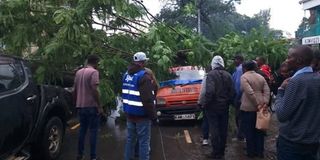When trees turn deadly:Nakuru's canopy crisis

Trees falls and crashes into four cars along Westside road on April 30,2025
For years, the Jacaranda trees in Nakuru have been a cherished part of the city’s identity, painting its streets with vibrant purple blossoms and offering shade and serenity.
But recent tragedies have revealed a darker reality: these once-celebrated trees are becoming hazards during the rainy season, among other tree species in and the outskirts of Nakuru city centre.
On April 30, 2025, a large tree fell along a busy stretch of Westside Road, damaging four vehicles—including a matatu and three personal cars.
Just a month earlier, and in an earlier incident in Kabarak, a falling tree claimed one life, turning beauty into heartbreak.
Additionally, on May 21, 2024, another tree fell near KFA, crushing five cars.
These cases have triggered alarm and a call for action from both county officials and environmental advocates.
In a phone call interview with Mtaa Wangu, Kennedy Mungai, the county’s Chief Officer for Environment acknowledges some of the trees are a risk to road safety, noting that the county has already rolled out a mapping plan to identify trees that pose a risk to residents starting May 1, 2025.
“We have started actively mapping trees across Nakuru to identify those that pose immediate danger. Some of the trees are old, yes, but many have been weakened by human activity like construction, excavation, loosening the soil and root systems,” says Mungai
Mungai emphasized that not all dangerous trees are old. “In areas with recent cabro work like DND where a tree fell recently, the soil is disturbed, and roots are compromised. Meanwhile, Jacarandas planted in untouched zones since 1958 still stand firm.”
Environmental activist James Wakibia supports this assessment but insists more must be done.
“The county should routinely prune overgrown trees, assess their health, and uproot those that are dry, rotting, or structurally weak,” he says, maintaining that “Human life must come first.”
Wakibia warns that overgrown branches pose a particularly high risk.
“Jacarandas are beautiful, but they become dangerously heavy when left unmaintained. There needs to be a shift toward urban-friendly trees, smaller, lighter species that are safer for high-density areas,” Wakibia says
He cautions against a blanket removal of trees, advocating instead for a smart, conservation minded approach.
“We’re not here to clear everything. The goal is balance protecting both people and nature. Also, for every tree removed, counties must plant better-suited alternatives,” he recommends
Mungai confirms that pruning and selective removal efforts are underway. “We have issued advisories asking residents not to park under trees during rains. Our team is inspecting root systems if we see roots lifting out of the soil, that's a clear sign the tree is under stress and must come down,” he concludes.

